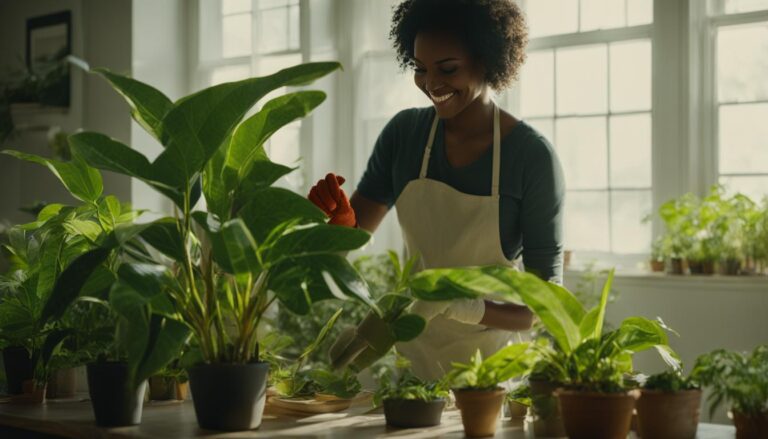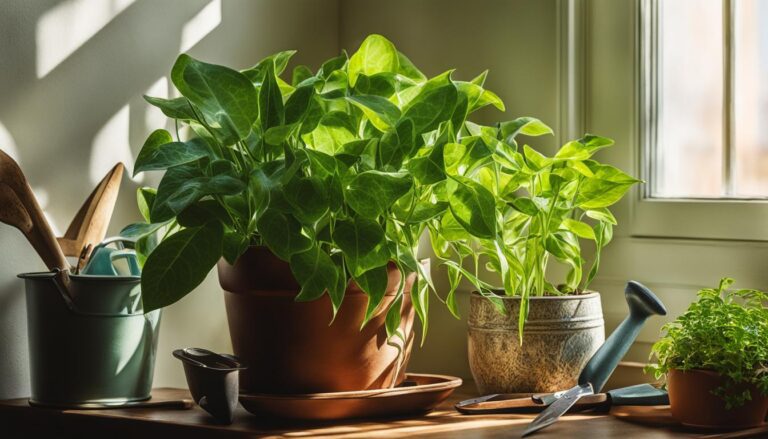
Welcome to my comprehensive guide on the Swiss Cheese Plant, also known as Monstera adansonii. If you’re a fan of indoor plants and looking to add a unique and tropical touch to your home, this houseplant is a perfect choice.
With its large, heart-shaped leaves that resemble Swiss cheese, the Swiss Cheese Plant is a stunning addition to any indoor space.
Monstera adansonii is a vining plant that can be trained to climb on a pole or allowed to hang naturally, making it versatile for different types of displays. There are two forms of Monstera adansonii – the Narrow Form with elongated leaves, and the Round Form with wider and more heart-shaped leaves.
Its distinctive feature, the holes in the leaves, is believed to be an adaptation that allows the plant to cover more area while conserving energy.
Throughout this guide, I will provide you with all the necessary information to care for your Swiss Cheese Plant, including its light and temperature requirements, watering and humidity needs, as well as essential care tips and propagation techniques.
So, let’s dive in and discover how to keep this tropical beauty thriving in your indoor space!
Light and Temperature Requirements for Swiss Cheese Plant
The Swiss cheese plant, also known as Monstera adansonii, is a tropical plant that thrives in bright, indirect light or partial shade. Providing the right amount of light is crucial for its growth and overall health.
Too little light can result in stunted growth and smaller leaves, while too much direct sunlight can cause leaf burn and damage.
To meet the lighting requirements of the Swiss cheese plant, place it in a well-lit room where it can receive bright, indirect sunlight.
Avoid exposing it to direct sunlight, especially during the hottest parts of the day. If the plant is not receiving enough light, the new leaves may have brown edges and fail to fully unfurl.
In terms of temperature, the Swiss cheese plant prefers rooms kept at a temperature between 64 – 81 degrees Fahrenheit. It can tolerate slightly lower temperatures, but anything below 64 degrees can slow down its growth and potentially harm the plant.
Avoid placing the plant near cold drafts or areas with fluctuating temperatures, as this can also negatively affect its well-being.
Light and Temperature Requirements for Swiss Cheese Plant:
| Light | Temperature |
|---|---|
| Bright, indirect light or partial shade | Between 64 – 81 degrees Fahrenheit |
| Avoid direct sunlight | Do not expose to temperatures below 64 degrees |
By providing adequate lighting and maintaining the ideal temperature range, you can ensure that your Swiss cheese plant thrives and continues to display its unique and beautiful foliage.
Watering and Humidity Requirements for Swiss Cheese Plant
Proper watering and humidity levels are essential for the health and well-being of your Swiss Cheese Plant (Monstera adansonii). Understanding the watering requirements and humidity preferences of this indoor plant will help ensure its growth and vitality.
When it comes to watering, it is important to strike the right balance. Overwatering can lead to root rot and other moisture-related issues, while underwatering can cause the plant to wilt and suffer.
Aim to water your Swiss Cheese Plant every 1-2 weeks, allowing the soil to dry out slightly between waterings. The frequency may vary depending on factors such as the time of year and ambient temperature.
It is crucial to provide adequate drainage for the plant as well. Make sure the pot has drainage holes to prevent waterlogging, which can harm the roots. If the plant sits in standing water, it is a sign that you are overwatering.
Swiss Cheese Plants thrive in high humidity environments. It is recommended to keep the room humidity level above 50 percent.
You can increase humidity levels by misting the leaves regularly or placing a tray filled with water near the plant. Another option is to use a home humidifier to maintain the desired humidity levels consistently.
By following these watering and humidity guidelines, you can create the ideal environment for your Swiss Cheese Plant to flourish and grow.
Watering and Humidity Requirements
| Watering | Humidity |
|---|---|
| Water every 1-2 weeks, allowing soil to dry out slightly between waterings | Maintain room humidity above 50% |
| Ensure proper drainage to prevent waterlogging | Use misting or a humidifier to increase humidity levels |

With the right watering routine and humidity management, your Swiss Cheese Plant will thrive and showcase its stunning foliage.
Remember to monitor the soil moisture and adjust watering frequency based on the plant’s needs. Maintaining the ideal humidity levels will promote healthy growth and prevent issues related to dry air.
By providing these essential care requirements, you will enjoy a vibrant and beautiful Swiss Cheese Plant in your indoor space.
Care Tips and Propagation for Swiss Cheese Plant
When it comes to caring for a Swiss Cheese Plant (Monstera adansonii), attention to detail is key. By observing the plant’s growth and addressing any issues promptly, you can ensure its health and vitality. Here are some essential care tips to help you maintain a thriving Swiss Cheese Plant.
First, be on the lookout for common symptoms that may indicate specific care needs. Yellowing leaves can be a sign of nutrient deficiency or overwatering. To remedy this, consider adjusting your watering schedule or providing the plant with a suitable fertilizer.
Curled and brown-edged leaves may suggest insufficient water and overexposure to the sun. In such cases, it’s best to adjust the watering routine and provide some shade for the plant.
Browning leaf tips with yellow halos are often a result of low humidity levels. To maintain the ideal environment for your Swiss Cheese Plant, it is recommended to keep the room humidity above 50 percent.
Consider using a home humidifier or implementing other methods to increase humidity. Lastly, if you notice your plant losing its dark green color, it could be due to excessive light or a lack of proper fertilization.
Adjust the lighting conditions or consider incorporating a balanced fertilizer into your care routine.
In addition to regular care, you may also want to prune your Swiss Cheese Plant to encourage a fuller appearance. Pruning can help shape the plant and remove any damaged or diseased foliage.
When it comes to propagation, there are two main methods you can explore: stem cuttings and seeds. Stem cuttings are a popular choice and can be easily rooted in water or a well-draining soil mix. If you prefer a more adventurous approach, you can try collecting and germinating seeds from mature fruit.
Caring for Different Varieties of Monstera Plants
Monstera plants come in various captivating varieties, each with its own unique care requirements. It’s essential to understand the specific needs of each variety to ensure their health and growth. Here, I will guide you through the care instructions for some popular Monstera plant varieties.
Monstera Adansonii
The Monstera Adansonii, also known as the Swiss Cheese Vine, is a beautiful trailing plant that thrives in high humidity levels. To keep your Monstera Adansonii healthy, make sure to mist its foliage regularly. This variety can also be propagated through stem cuttings. By snipping a healthy stem and placing it in water or a well-draining potting mix, you can expand your Monstera collection with ease.
Monstera Thai Constellation
The Monstera Thai Constellation is a stunning variegated variety that requires a bit more attention. This plant prefers higher humidity levels, so misting the leaves regularly will help keep them happy and glossy. Place your Monstera Thai Constellation in a well-lit spot with bright indirect light. Its unique variegation adds a touch of elegance to any indoor space.
Monstera Peru
Originating from the rainforests of Peru, the Monstera Peru shares similar care requirements with the Monstera Deliciosa. This variety benefits from increased humidity levels and can be propagated through stem cuttings. Pruning the Monstera Peru is also essential to maintain its compact and bushy shape.
Monstera Epipremnoides Sp
If you’re a fan of climbing plants, the Monstera Epipremnoides Sp is perfect for you. This variety requires support for its growth, such as a trellis or moss pole. Proper training and pruning will help guide its climbing tendencies and create an impressive display in your home.
Monstera Aureopinnata
The Monstera Aureopinnata radiates rainforest elegance with its golden-tipped leaves. To keep this variety thriving, maintain higher humidity levels by misting regularly. Its stunning foliage will add a touch of luxury to any indoor space.
FAQ
How often should I water my Swiss cheese plant?
The Swiss cheese plant should be watered every 1-2 weeks, allowing the soil to dry out between waterings.
What kind of lighting does the Swiss cheese plant require?
The Swiss cheese plant thrives in bright, indirect light or partial shade. Direct sunlight should be avoided as it can cause leaf burn.
What temperature range is ideal for the Swiss cheese plant?
The Swiss cheese plant prefers rooms kept at a temperature between 64 – 81 degrees Fahrenheit.
How can I increase the humidity for my Swiss cheese plant?
The Swiss cheese plant thrives in high humidity levels. It is recommended to keep the room humidity level above 50 percent. A home humidifier can be used to increase humidity if necessary.
How do I propagate the Swiss cheese plant?
Swiss cheese plant can be propagated through stem cuttings or seeds.
How can I address common issues with my Swiss cheese plant?
Common issues to watch for include yellowing leaves (indicating lack of nutrients or overwatering), curled and brown-edged leaves (resulting from too little water and overexposure to the sun), browning leaf tips with yellow halos (caused by low humidity), and loss of dark green color (due to excessive light or lack of fertilizer). Pruning can be done to create a fuller-looking plant.






